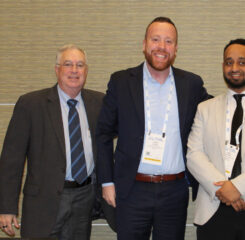A report from Centers for Medicare & Medicaid Services (CMS) contractor Abt Associates on the 2022 nursing home staffing study was found on the CMS website this week, ahead of the proposed staffing standards that are expected to be released to the Federal Register imminently. In an Aug. 29 KFF Health News article, CMS called the report a “draft” and stated that it had been posted in error. However, this was not before being reported in the trade press and circulated publicly.
It remains unclear how heavily CMS relied upon this report in developing minimum staffing standards or what standards will be proposed, but the Office of Management & Budget (OMB) concluded review of the proposed rule on August 29 and presumably passed the rule to the Federal Register a day or so later. The rule had not yet been published in the Federal Register on August 30.
Notably, the report failed to provide conclusive evidence for a specific standard. Authors noted that there was “no obvious plateau at which quality and safety are maximized or ‘cliff’ below which quality and safety steeply decline.” Additionally, authors of the report noted that while quality and safety “consistently increase” with Registered Nurse (RN) staffing levels, changes to quality and safety are only noted at the highest levels of nurse aide staffing. LeadingAge notes that this conclusion, however, is based on the quantitative data reviewed in this study, such as the nursing home quality measures and other empiric data. While interviews conducted as part of the study indicated that staff, residents, and families felt that aspects of quality and safety such as resident-centered care, quality of life, and staff burn-out were impacted by staffing levels, these qualitative experiences are more challenging to measure and not currently captured in CMS quality measures.
Abt Associates undertook three types of activities to complete this study. As part of “formative activities” to help inform the study design, Abt Associates conducted a literature review and hosted a stakeholder listening session. For the literature review, Abt Associates reviewed existing literature published from 2019 to 2022 that spoke to the relationship between nursing home staffing and quality and safety. They additionally examined existing state and federal standards for nurse staffing, the role of different nurse types in quality and safety, costs associated with nurse staffing in nursing homes, and costs associated with implementing minimum nurse staffing requirements. The listening session, in which LeadingAge was a participant, solicited feedback on study design.
“Qualitative activities” in the study included a second stakeholder listening session in which LeadingAge once again participated and nursing home site visits. In the listening session, stakeholders provided feedback on the benefits and challenges associated with implementing and enforcing a minimum staffing requirement. For the site visits, Abt Associates interviewed more than 360 nursing home staff, residents, and family members in 31 nursing homes across the country and completed surveys on missed care with approximately 170 nursing home staff.
Nursing homes selected for site visits varied in size, ownership type, payer mix, use of agency staff, Five Star Quality Rating, resident acuity, and other factors. Nursing homes were selected from each of the 10 CMS regions and included both urban and rural nursing homes. During site visits, Abt Associates collected qualitative information on the importance of adequate staffing, potential barriers to increased staffing levels, ways that nursing home staffing relates to quality, recommended staffing ratios, and potential unintended consequences associated with a minimum staffing requirement.
The “quantitative activities” included analyses of empiric data from Payroll-Based Journal, Nursing Home Care Compare measures, the Minimum Data Set, Certification and Survey Provider Enhanced Reports, and data from timed observations of clinical tasks in 20 nursing homes. These analyses examined the relationship between staffing and quality and safety, simulated the impact of nurse staffing on missed care, estimated the impact of requirements on staffing and quality and safety, and estimated the costs associated with increasing staffing based on minimum standards. Abt Associates additionally utilized Medicare Skilled Nursing Facility Cost Report data to estimate the impact of staffing on hospital discharges, emergency department visits, and community discharges, and the potential cost savings to Medicare based on changes in these metrics.
Abt Associates utilized the data from study activities to develop potential options for minimum staffing requirements. Abt Associates presented options broken down into different nurse types, quantified by hours per resident day (HPRD), with estimates for scenarios in which licensed nurse staff could be substituted across levels (RNs for LPNs) and scenarios in which substitutions were not permitted. Each option included low, medium, high, and highest staffing levels and estimated costs, percentage of nursing homes that would need to add staff to meet the standard, and the predicted impact of the standard on nursing home quality and nursing home safety.
A four-requirement option in which licensed nursing staff could be substituted across levels to meet requirements ranged from 3.30 total nurse staff HPRD at an additional $1.5 billion per year at the lowest staffing level to 3.88 total nurse staff HPRD at an additional $5.3 billion per year at the highest staffing level. Abt Associates estimate that these minimum staffing options would save an estimated $187 million to $465 million per year in Medicare spending based on reduced hospitalizations and emergency department visits and increased community discharges.
For options in which licensed staff could not be substituted across levels to meet standards, a two-requirement option would set standards for only RN and nurse aide staffing, ranging from 0.45 HPRD for RNs and 2.15 HPRD for nurse aides at an additional staffing cost of $2.2 billion per year at the lowest staffing level up to 0.70 HPRD for RNs and 2.45 HPRD for nurse aides at an additional $6 billion per year at the highest staffing level. A 4-requirement option would specify standards for RNs, Licensed Practical Nurses (LPNs), nurse aides, and total nurse staffing and would range from 3.30 total nurse staff HPRD with additional staffing costs of $2.9 billion per year at the lowest level, with additional specific recommendations for each nurse type, to 3.88 total nurse staff HPRD at $6.8 billion per year at the highest level.
A full breakdown of the recommended HPRD for each nurse type in addition to data on cost and quality and safety impact predictions is available in Exhibits 5.1 Cost, Quality, and Safety Implications for Four Minimum Nurse Staffing Requirement Options and 5.2 Cost, Quality, and Safety Implications: Two- vs. Four-Nurse Staffing Requirement Structures in the Abt Associates report.
Though the Abt Associates report has been removed from the CMS website, a copy of the report deemed to be a “draft” by CMS can be accessed here.
Follow all of our staffing ratios updates in this serial post.

 Shutdown Week Three: Impact of Ongoing Closure on Affordable Housing
Shutdown Week Three: Impact of Ongoing Closure on Affordable Housing Colleagues on the Move, December 17, 2025
Colleagues on the Move, December 17, 2025


